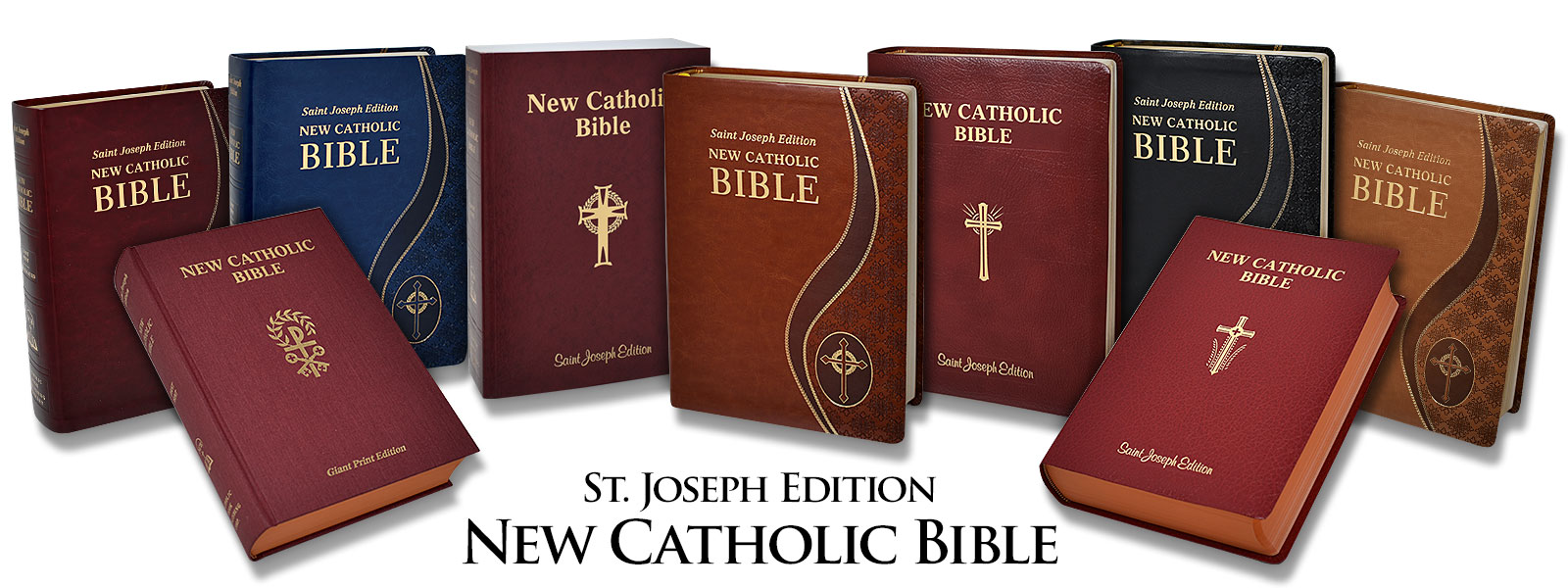
I just received a copy of the New Catholic Bible in black DURA-LUX (imitation leather) binding (St. Joseph Edition) from Catholic Book Publishing Company. Today, I’ll give a brief look at the bible’s construction, printing, and contents. Over the next week or two, I’ll be reading through sections of it to get a better sense of its language style and notes. Although the New Testament and Psalms have been available for a few years now, this is the first time I’ve spent any quality time with this translation, so I’ll be looking at the Gospel of Luke, Paul’s letter to the Galatians, and some selections from the Old Testament.
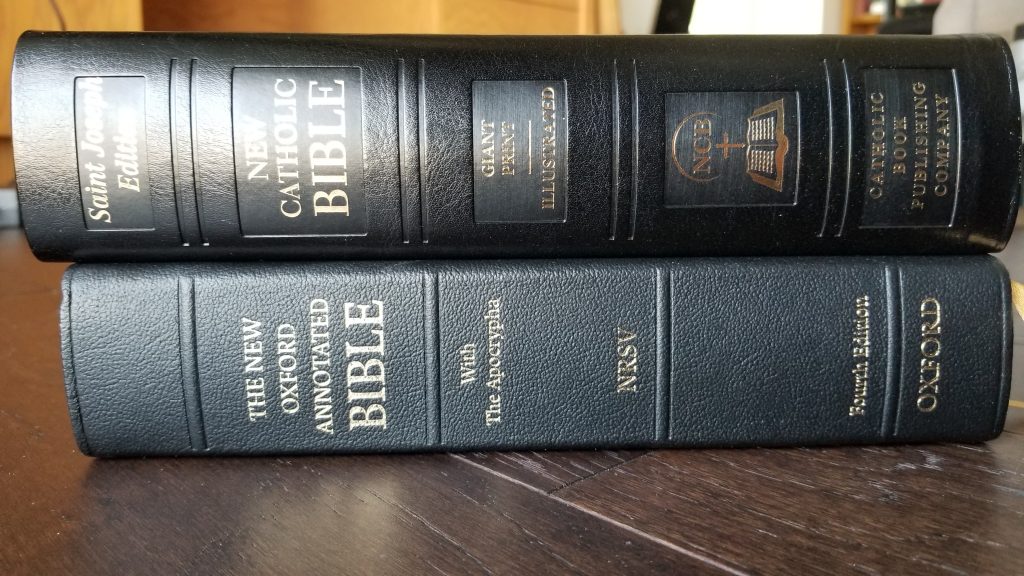
This is a large bible — a bit larger than the recent genuine leather editions New Oxford Annotated Bible (4th and 5th editions). Overall, it’s similar in size to most study bibles on the market. It is smaller than the NAB Family Bible also published by Catholic Book.
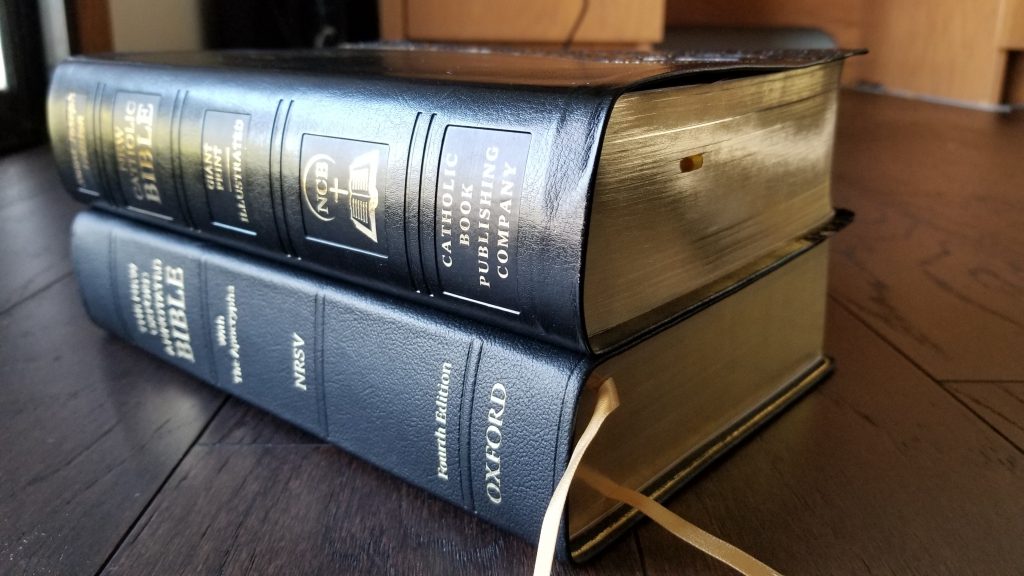
The NCB features a 1/4-inch single-sided ribbon, gold gilded pages, and a DURA-LUX imitation leather binding, which has a very nice feel. This is a similar imitation leather to the Great Adventure Catholic Bible from Ascension Press. The binding is sewn using the same style as most books from Catholic Book Publishing Company: the signatures are small, and the folded sections are difficult to discern except at the very edge of the spine. This makes for a very even appearance from the spine to the edge of the pages when the book is closed.

The print is large, clear, and easy to read from a comfortable distance. As with most giant-print bibles, the page layout is not especially elegant, and the large print tends to look cramped or packed onto the page without much white space. It is exceptionally easy to read, though, and many readers will appreciate its practicality.
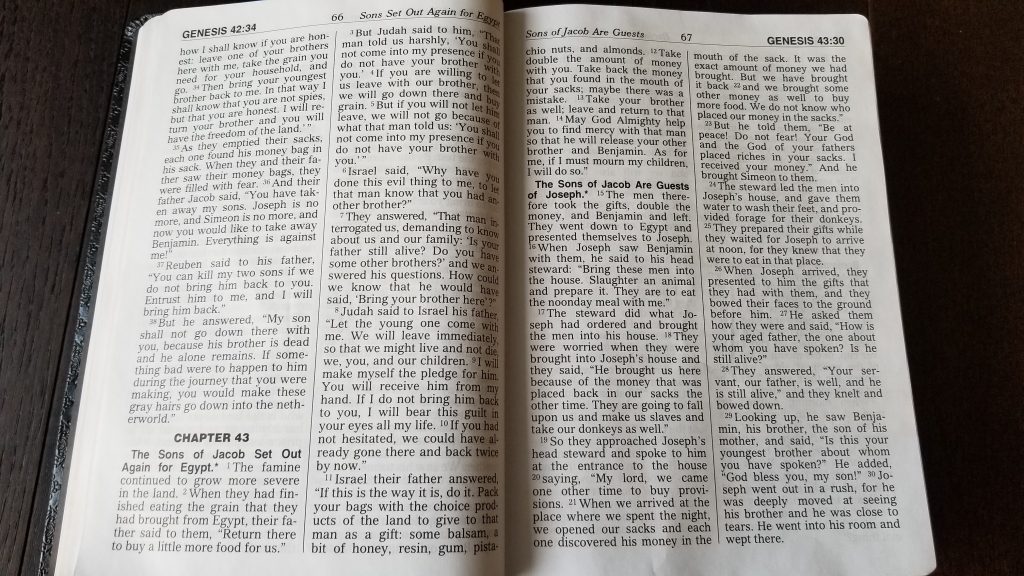
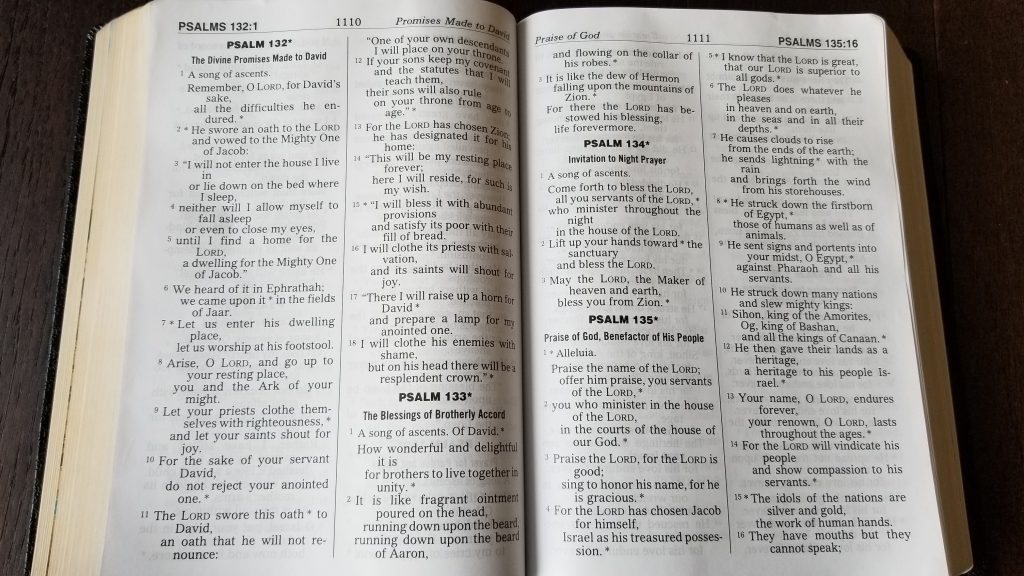
The footnotes are printed at the end of each biblical book, rather than the bottom of the page, so referring to notes will require some flipping back and forth. On the other hand, it can potentially allow for less distraction when reading extended passages of scripture. If the notes are not on the same page, it is easier to keep reading, rather than flipping to look at each note!
Similar to other St. Joseph editions from Catholic Book, this bible features inserts with color illustrations, as well as full-color informational pages. The layout of the information inserts is well-designed and attractive.

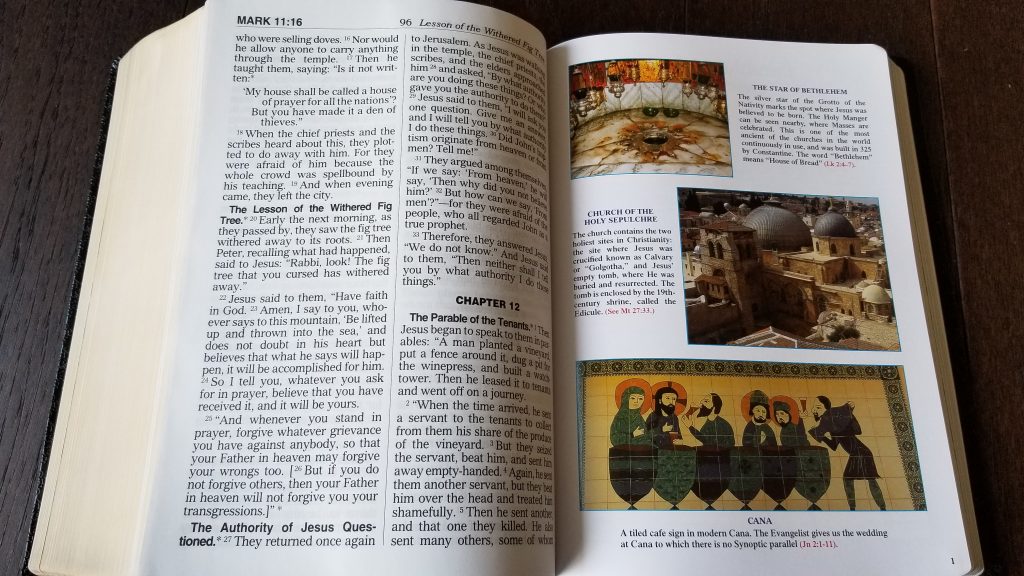
The front matter displays the nihil obstat and imprimatur for both the Old and New Testaments. It also contains an official canonical rescript from the Catholic Bishops Conference of the Philippines.
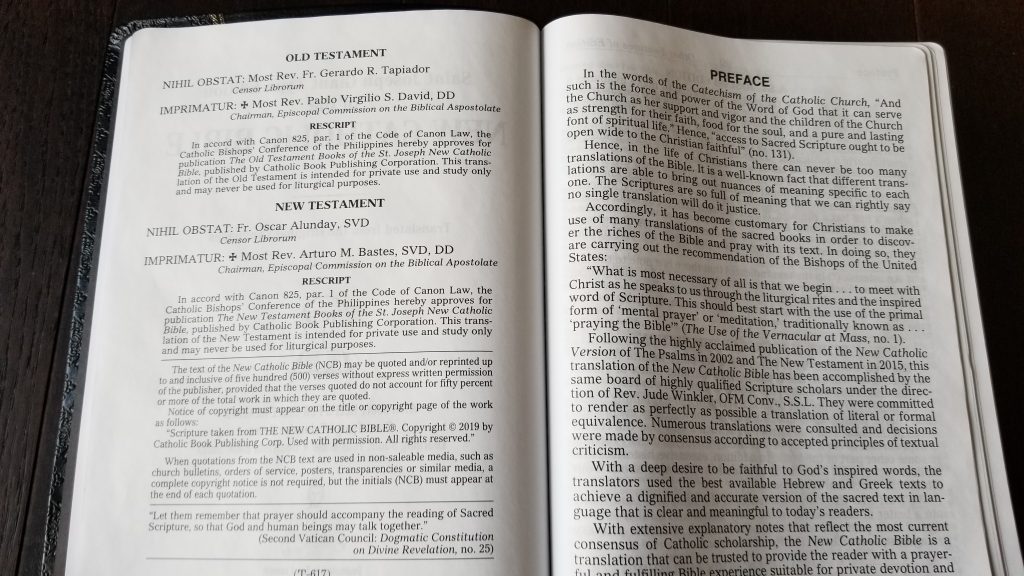
I’m looking forward to spending time with this translation over the next several days!
Thanks for the review! Looking forward to seeing how this compares to the NABRE. From what I have seen thus far I would rather give a new Catholic (or anyone in general) a NCB, and hopefully the corresponding value editions are forthcoming.
This giant print edition looks very nice though. The style and type on the spine reminds me of Catholic Bibles from the 50s-60s. I wonder how well the dura-lux will hold up. The synthetic covers are really a mixed bag. I have seen some hold up well and others not as well. I haven’t seen any made in recent years crack or chip, so that is a good sign!
I have been using the NCB’s New Catholic Version in New Testament form for a few years now (St. Joseph Illustrated Study Edition by Catholic Book Pub.) and I have to say that it can easily be called the NABRE with slight translation differences.
IF the new entire NCB is the same as the prior NT editions, then quite often the introductions and footnotes tend to be way more in line with traditional Catholic theology and tradition such John easily held to be author of the 4th gospel; Annunciation uses “Hail, full of grace” and notes to it are solid; Mt 16 upholds Peter’s primacy as leader and popes as successors.
What is curiously and sadly lacking and disappointing to me is that the Eucharist never gets real Catholic attention or teaching in the footnotes for at any of the Last Supper synoptic accounts. These notes could easily be used by many Protestant Christians in this regard. And most surprisingly not even in John 6 will you find even just ONE little use or mention of the word “Eucharist” let along any eucharistic teaching. I was quite astonished considering how solid much of the intros and other footnotes are.
Not sure what I will do at this point. Probably just pass on adding yet another Bible to my library.
“full of grace” is not a good translation NABRE and NJB don’t use it. It more accurately translated
“(highly) favoured one”.
Technically neither translation is wrong.
Technically “full of grace” is a paraphrase rather than a formal translation of the Greek.
That’s not true. Full of grace is the better translation of kecharitomene. The word literally translates to completely endowed with grace. There’s no version of that word that has “favored” in it.
Chaire Kecheritomene are the exact words, according to St. Jerome that Luke penned at verse 28. Full of grace, and the meaning thereof is what the original Latin Vulgate Bible displays, as does St. Jeromes explanation of his translation. Who might know better the meaning of that Koine Greek phrase… The Catholic Church of the first four centuries, or modem scholars not in possession of Jeromes original manuscripts or understanding of the Catholic Church’s original teaching?
Brian is correct. The Greek word is not found outside of the New Testament. It is used almost as a title of sorts and implies Mary is in a category of her own.
Peace.
What should really surprise you is the evidence that Mary had a regular family life. See Matthew 1:25 and Matthew 23:55-56. And don’t let anyone try to sell you on the idea that the Greek ‘adelphoi’ or ‘adelphai’ means ‘COUSINS’. They don’t call Philadelphia the city of Cousinly love, do they?
I have been doing some reading of the NCB. Commenting on the actual translation, it reads somewhere between the New American Bible and the NRSV.
While it is true that the NCB is advertised as not being a “gender-neutral” translation, this does not mean that the text is free from all inclusive-language (for instance, Luke 1.48 uses “servant” instead of “handmaiden”–the Greek is feminine).
But in most every spot where you would expect a Catholic Bible to have controversy (i.e., Isaiah 7.14 and Luke 1.28, etc.), the NCB renders things along the lines of traditional Catholicism. There is generally never any rocking of the boat.
The highlight of the translation is not the translation itself. That part is often a bit “mamby pamby.” It lacks any type of character or substance that makes it stand out of from being anything more than bland.
The renderings at time show little attempt to do anything but give words on a page so that there will be something to offer lengthy commentary in the footnotes–and this is where the NCB shines. The commentary is the number one reason anyone would want this Bible. It is rich with a balance of historical-critical and traditional Catholic teaching.
But in the GIANT TYPE version, where the footnotes are placed at the end of the book and you are forced to read the books alone–except for the Psalter, you are often left reading a text that sometimes reads as if were designed to exist for the sake of the commentary alone. It just isn’t that good.
One can compare the NCB reading as offered in your photo of Genesis 43.19-30 with the NABRE. Notice how well the NABRE flows. The NCB is stunted in many places–to illustrate in just one place, vss. 21-22 where the word “brought” gets used three times so close together that it feels like you are tripping over the word.
I happen to be a fan of Rev. Jude Winkler, but when I opened the NCB up to Genesis 1 and came to verse 11 and saw a typo (missing the closing quote marks to God’s words), I felt it was a bad omen. It wouldn’t be noticeable in a smaller printing–but in a large print Bible–OUCH! (There was a similar typo in last year’s New Testament NCV printing where an entire verse was missing from one of Paul’s epistles too–yeech!)
Again, the footnotes are what make up this Bible. It’s a marvelous work. The Psalms are an outstanding translation on their own. Because so many people are confused with the NABRE footnotes expecting them to be commentary (they are not–they are a critical apparatus), the New Catholic Bible is what you would get or give to the person who wants a Catholic Bible who wants a copy of the Scriptures with a dependable Catholic commentary built-in. The problems are tiny compared to the commentary. It’s delicious.
Thank you for your review. I am not convinced to buy the New Testament translation of this.
*now convinced. Sorry for the typo.
“Servant” instead of “handmaiden” hardly seems like a bow to inclusive language, it is simply a substitution of a modem word which is on common use for an older, somewhat old fashioned word that is no longer in common use. Granted, I don’t think there is anything wrong with using slightly old fashioned words that aren’t in common use, for example, I prefer “behold” to “look at”, but it is really a question of translation philosophy, and the NCB definitely has a philosophy that prefers more modern words.
You misunderstood me.
I gave but a sample of the many times the NCB uses inclusive terminology by offering but one verse, however the NCB does this repeatedly.
And it is not that the word “behold” is chosen as a rendering that I meant to point out. It was that a word was repeated over and over and over again in close proximity. The original Hebrew doesn’t demand such a translation.
Huh? You seen to have completely misunderstood literally every single word I wrote.
I would urge patience in dealing with fellow commenters, Biblical Catholic. Carl contributed valuable impressions of the NCB in this thread, and even if he misunderstood your comment, I urge you and all readers to be constructive in your contributions, rather than destructive.
The terminology of “inclusive language” is debatable and will vary in meaning depending on the context. I think the NCB translators didn’t go to extreme lengths to make all instances gender neutral, such as changing singular and masculine pronouns to plural, but one could arguably say it has more “inclusive language” than the RSV, for example. There are a lot of examples to consider in both testaments.
I really enjoy hearing everyone’s perspective on these translation issues. Everyone has something to add which is why I enjoy my parish Bible study so much! Carl, you have a really cool story, I must say. I am a fan of Phantom of the opera as well and I hope your 3D project is successful! I missed the 3D TV on the US commercial market, but I might have to look at upgrading my projector! 😉
I received my black Dura-lux edition. It’s a very nice one. I hope at some point they’ll release a smaller one, such as the medium size NABRE, but this will do nicely, especially for devotional reading or teaching and proclamation in a group setting when it’s a distraction to have to put on reading glasses.
Having had the NCV psalms and NT, I have enjoyed the notes and have found them more helpful than the NABRE notes. The text is better, too, in my opinion— not as clunky (cf. Matthew 19:6 for comparison).
The layout of the Bible is typical St. Joseph edition. Same cheesy paintings within, etc., but I like all the inserts and helps. Overall I’m very pleased with this Bible. I love that CBP Co. still does signature sewn bibles. Even with their limited cover options, they seem to get the importance of quality.
Since they don’t do genuine or premium leather Bibles, I figure this edition is a good candidate for a Leonard’s Books rebinding with premium leather. They do very good work.
I noticed that all the people who approved this version are in the Philippines. So, I can I safely assume this is meant for the Philippine market?
It is meant for the entire English speaking world, the only reason they went to the Philipines for approval is that they seem to be the only bishops in the English speaking world who are interested in new translations. This is also where the New Living Bible Catholic Edition was approved.
The New Living Translation Catholic Edition (and the ESV-CE) was actually approved by the Catholic Bishops Conference of India.
I am curious as to who paid for this project. It is odd to put together a new translation and have so little information about who is behind it.
I’m pretty sure the company itself, Catholic Book Publishing, is the one who is behind this project. They’re a giant Catholic book publisher and would like to quote bible verses in their many other books without having to be a royalty to the copyright holders of the other bible translations.
Im beginning to wondef if the NCB has simply plagiarized the RSV.
That is correct my point however is that they couldn’t have gone to the American bishops because the American bishops are so wedded to the NABRE but they have no interest whatsoever in even looking at another translation. The bishops of England and Canada you don’t seem to care at all or else they’re so preoccupied with the issue of the lectionary if they don’t have time for anything else. Australia and New Zealand? You get nothing from them but the sound of crickets when asking about new translations.
It seems the third world has taken up the responsibility that the first world has given up.
Australia and New Zealand both seem to always follow England.
Canada likes the NRSV
Africa took the NABRE and changed the footnotes to create the New African Bible
The English speaking Caribbean nations approved the RSV-2CE for their lectionary
India approved the ESV-CE
So it only makes sense that the Philippines would want to approve something too, since they have historically been following the United States. I’m sure they jumped at the idea of having their own English translation (even if it’s just for personal devotion)
It is strictly financial. They don’t want to pay royalties to the CCD for the usage of the NABRE in publications. India is being used for money. The USCCB won’t authorize a new translation because they are involved in revising the lectionary and psalter. Until that work is done, it is just not possible to analyze and approve yet another translation. There is no need to bash the US bishops. They are faithful to their work and to us.
The problem with them calling this Bible the “New Catholic Bible” is that it causes confusion with the CTS’s “New Catholic Bible”
https://www.ctsbooks.org/product/new-catholic-bible-paperback/
CBPC should have just called it the “St. Joseph’s Translation” or something like the “New Asian English” translation or “Far East English” translation.
I have some questions about the translation and the notes:
1 The translation is really good? Is better than Rsv2CE ?
2 Biblical Catholic wrote : “Even in the RSV CE2, the vast majority of the Messianic passages in the OT are still translated in such a way as to obscure a Christian interpretation.”
The NCB is more traditional in rendering the Messianic passages in the OT?
3 The notes in NCB are conservative or liberal? Deacon Dave in his comment wrote : “What is curiously and sadly lacking and disappointing to me is that the Eucharist never gets real Catholic attention or teaching in the footnotes for at any of the Last Supper synoptic accounts. These notes could easily be used by many Protestant Christians in this regard”.
The notes are too ecumenical ? The Marian Dogmas are mentioned?
I’m currently working my way through the Gospel of Luke in the NCB, comparing it verse-by-verse against the NABRE and comparing all the notes as I go along. From what I’ve seen so far, I’d make the following comments:
1. In my opinion, the translation is better than the RSV-2CE. It has a better English flow than the NABRE also. This is a readable translation without sounding like a paraphrase.
2. I haven’t checked enough of these passages to make a blanket statement, but I’ve certainly noticed that the NCB allows tradition to influence its translation choices. It translates Gabriel’s greeting to Mary in Luke as “Hail, full of grace,” and in Ezekiel’s vision of the valley of the dry bones (Ezekiel 37:1-14), the NCB says that Ezekiel prophesied to the “Spirit” (capitalized) as opposed to the “breath” in the NABRE. If a person is aiming to translate the original meaning of the text, the NCB’s translation is probably anachronistic (especially Spirit with a capital “S,” which suggests that the author is referring to the Holy Spirit), but from another standpoint, the NCB is allowing tradition to influence its reading of the Old Testament, which Christians have done since the earliest days.
3. This question is not easy to answer, especially since each person probably has a unique idea of what “conservative” and “liberal” mean. The NABRE notes and the NCB notes are VERY different. The NABRE notes focus on providing information that helps the reader to understand the text *on its own terms* regardless of any later doctrinal definitions or developments. This is often misinterpreted as a denial of tradition or a denial of the Church’s teaching. It is not intended as such. It is intended to help readers interact with the text as the original author intended, which sometimes requires modern readers to set aside their preconceptions and even doctrinal presuppositions. On the other hand, I would describe the NCB’s notes as “mini homilies.” The NCB is much more concerned with explaining how a text fits in with broader theological ideas and how it applies to us today. The book introductions in the NCB do a masterful job of weaving together historical and literary insights with traditional reflections on the text and its importance for our life of faith. I found the NCB’s notes on Mary in the first chapter of Luke to be almost hagiographical — emphasizing Mary’s holiness to an almost excessive degree. It also points out that the Church prays the Canticle of Zechariah and the Magnificat daily in the Liturgy of the Hours. I don’t find these notes to be ecumenical. They are unmistakably Catholic.
Marc,
I thank you very much for your reply. Your comments are very interesting. Thanks a lot!
Got a bit of a task for someone who has one. See how these verses are rendered. What’s in parentheses is what I hope for. I don’t expect the phrases to be worded exactly. Please let me know what is in parentheses in this translation. Include any other major verses I’ve forgotten.
Mt 24:28 (eagle)
Mt 21:7 footnote
Jn 8:58, 3:5, 5:24, 6:26, 6:53 (Amen)
Lk 1:28
Lk 1:34 (shall)
Jn 3:5 (born again)
Psalm 45:10 (Queen)
Mk 9:43 (is it even there)
Mt 16:18 (Hell)
Mt 16:26 (soul)
Mt 20:16 (For many are called but few chosen)
Jas 5:14 (priests)
Mt 26:50 (friend, whereto art thou come?)
Acts 1:20 (let another takes his bishopric)
1 Tim 3:15 (‘the’ foundation of Truth)
In most of these, the NCB is similar to other modern translations:
Mt 24:28 – “vultures”
Mt 21:7 – footnote: “He sat on them [the cloaks]: from Mark (11:2) and Luke (19:30), we know that Jesus rode on the colt. It was customary for a mother donkey to follow her offspring closely. Hence Matthew mentions two animals.”
Selections from John: All of these verses read “Amen, amen…”
Lk 1:28 – “Hail, full of grace”
Lk 1:34 – “How will this be, since I am a virgin?”
Jn 3:5 – “born of water and the Spirit”
Psalm 45:10 – “queen”
Mk 9:43 is translated, and 9:44 is in brackets in the text.
Mt 16:18 – “netherworld”
Mt 16:26 – “life”
Mt 20:16 – “the last will be first and the first will be last”
Jas 5:14 – “presbyters”
Mt 26:50 – “Friend, do what you are here to do.”
Acts 1:20 – “Let another take over his position.”
1 Tim 3:15 – “…the Church of the living God, the pillar and bulwark of the truth.”
New Catholic Bible is in the tradition of older editions of the Bible, which have been held as authoritative in the Church for years. It is one of the few Bibles, which are more literal equivalent, like; Douay Rheims Bible, and Revised Standard Version Catholic Edition, than other editions in English.
The NABRE uses formal equivalence. It is a very literal translation of the best manuscripts available (biblia Hebraica, Nestle-Aland Novum Testamentum Graece along with the Clementine Vulgate). ll bibles use some paraphrasing. It’s impossible to translate another language to English without using some dynamic equivalence. The D-R suffers from the fact that many Greek words do not have a Latin equivalent. Douay-Rheims is an example of strict formal equivalence
The actual best manuscripts available are no longer available, long lost to history. There are no longer any “inspired” manuscripts available to translate from. The documents you mentioned bear no connection to the translation of the original Latin Vulgate Bible in 405 AD. If any given”Bible” translation doesn’t agree with the original Holy Spirit inspired, inerrant word of God Bible, can it really be called an authentic Bible? Take politics out of Bible translation, and you get back to the authentic Word of God.
Just reference the original.
I used this bible to complete my conversion (much to the horror of the Pastor at my church). He saw it in our bookstore and had it pulled. While I love the bible I am concerned with the somewhat sketchy origins (and being authorized by the Philippines and not being approved for liturgy doesn’t help. Feels very “offshore”. Additionally, It looks like 2 men translated the OT and 2 men worked on the NT. What was their source material? It claims from “the original languages”. I searched for reviews but didn’t find any.
I do wish that Catholic Book Publishing Company included more information on who the translators were and which sources they used. I haven’t seen any list of translators, so I have no idea how many people were involved. Fr. Jude Winkler OFM Conv. led the project.
I’m not terribly concerned about the overseas imprimatur. Part of the goal of this project was to produce a Catholic Bible that wasn’t explicitly “American” like the New American Bible. Also, it has been notoriously difficult to get the USCCB to review new Bible translations for an imprimatur. The Common English Bible publishers stated that they contacted the USCCB about an imprimatur, but they were not interested. It is an extremely long process, where a committee of experts reviews the entire biblical text, and in many cases, they make recommendations for changes that need to be incorporated by the publisher. The USCCB is already involved in a multi-year project to revise the NAB New Testament, so they have their hands full.
I’m not bothered by the lack of approval for liturgy either. The Church is trying to move toward having a single Bible translation for all liturgical readings in each local bishops conference. For example, the NRSV is approved for private reading, prayer, and devotion in the US, but not for liturgy. This is because the NAB is the only translation currently approved for liturgy in the US. The NRSV is used in the liturgy in Canada.
New Catholic Bible is a good edition, and it is appropriate, alongwith Revised New Jerusalem Bible, to be adopted for the liturgy and lectionary in the Churches in both Asia and Europe.
I have a comment and question about one verse from the NCB. I refer in particular to Philippians 2:28:
“Therefore, I am all the more eager to send him [Epaphroditus] in order that you may rejoice on seeing him again and I may thereby feel less anonymous.” The last word in the verse, “anonymous,” seems to me problematic.
Other translations render the end of the verse with words or phrases such as:
– “sorrowful” (King James)
– “anxious” (RSV)
– “that I may have less anxiety (NIV)
– “that will make me happy and lighten my cares.”
My Greek is weak, but as one can readily see from these various translations, they are all pretty close.
Is there any way that the Greek could appropriately yield the translation “anonymous”? Or is this a case where the translator just fell asleep on the job? It just seems to me way out in left field.
That’s an interesting one. If any other readers have insight, feel free to jump in! I just checked the NET Bible’s voluminous notes, but there are no notes dealing with that part of verse 28. The NET translates the phrase as “free from anxiety.”
more without grief: less sorrowful, nothing about about anonymous!
Sending Epaphroditus back will decrease their sorrow only in part (Ephesians 2:26)
It appears that using the word anonymous in Philippians 2:28 is an error in the print version of the NCB. If you look at the electronic version of the NCB Bible on biblegateway.com, you will see that instead of the word “anonymous”, the word anxious is used. Below is the NCB’s verse of Philippians 2:28 as it appears on biblegateway.com
28 Therefore, I am all the more eager to send him in order that you may rejoice on seeing him again and I may thereby feel less anxious.
Below is the link to Philippians chapter 2 on biblegateway.com
https://www.biblegateway.com/passage/?search=Philippians%202&version=NCB
So it seems like the Catholic Book Publishing Company caught and corrected the error for their electronic version on Biblegateway but the print version continues to have this error. To my knowledge there are no electronic versions of the NCB available for purchase.
As no original manuscripts used by St. Jerome to translate the original Bible currently exists, it is impossible to know for sure exactly what koine greek words were used in any given scripture passage. The best reference would perhaps be one of the early Latin Vulgate Bibles still in existence, the earliest Vulgate codex apparently via the 8th century. One could check the Codex Vaticanus or Sinaiticus ~AD 350, but apparently they don’t completely agree with the Vulgate either.
Nihil Obstat and Imprimatur are from the Philippines. Who is this bible intended for?
I feel like an ecumenical Bible yet CE is ideal. I have the NRSV Anglicized CE, I like it but I hear so much controversy with it. How could you compare the NCB with the NRSV-CE? Or should I forsake my mission in finding the best of these two and settle with India’s ESV-CE? If the NABRE is so “pedestrian” and the NRSV is too “partisan” while the NCB is “opaque”
The RNJB I can only find in one edition, while the ESV-CE might be great but seems to attract a small minority of American Catholics. So far my best luck has been with the Catholic Bible Press NRSV—but wait what about the NABRE after all? No it’s too “pedestrian” English Catholicism is quite confusing when it comes to the ideal translation.
Hi Dillon,
I wrote an in-depth review of the NCB in a series of three posts last year. Here is a link to the first post in the series:
http://catholicbibletalk.com/2020/05/in-depth-with-the-new-catholic-bible-part-1/
I also extensively compared the NCB to the NABRE, both in the translation and the footnotes.
In my opinion, the criticism of the NABRE as “too pedestrian” is outdated. Prior to the revised edition in 2011, the NAB Old Testament used occasional renderings that were jarringly informal. My favorite example is Jeremiah 20:7, where the NAB translated the prophet as saying “You duped me, O LORD, and I let myself be duped.” It’s quite possible that was an accurate translation, but it sounded jarring. The NABRE now reads, “You seduced me, LORD, and I let myself be seduced.” Overall, many of the criticisms of the NABRE are outdated criticisms from previous versions of the NAB. The revised edition is quite excellent overall.
The NRSV’s literary style is a bit smoother than the NABRE. The NABRE can be stilted and difficult to read in the New Testament, especially in Paul’s letters, because it stays very close to the underlying Greek grammar, with its run-on sentences and abrupt transitions. The NRSV smooths out the difficulties more than the NABRE, while remaining a largely literal translation. The NRSV is widely criticized for its extensive use of inclusive language (“brothers and sisters” instead of “brothers” for example, or plural forms like “those” instead of the singular “he”). There are widely varying opinions about this. I read the NRSV frequently. It doesn’t bother me enough to make me stop reading it. But occasionally the inclusive language sticks out like a sore thumb compared to the familiar language from the NABRE which I hear at Mass every Sunday in the United States.
I liked how the footnotes of John 10:22-39 referenced1 Maccabes 4:36-39 as well as 2 Maccabees 1:9-18 and 10:1-8. My brother is a protestant and although I’m in RCIA classes right now and haven’t been exposed to many Catholic editions yet, I feel that this NCB is a good place I started at. I love the footnotes, they are helping me and that’s what matters most. If anyone can recommend a better version I should save up for, please do and tell me why if you can please.
jao
I like that it includes verses like Acts 8:37 that most modern translations leave out “because the oldest manuscripts don’t contain them”.
I’ve been doing some comparisons and further reading, Aleteia has the best overall overview of the Catholic Bible editions suitable for study. They don’t mention the NCB. I’m starting to think the best middle-ground between all of these different translations is the older RSV-CE since it is closer to the NRSV-CE than the NAB-RE while being more ecumenical (to my knowledge) than the NAB and NCB editions. Aleteia states the three best translations for study-oriented reading are NRSV-CE, RSV-CE and NAB-RE. There seems to be a consensus that the RSV is more favored for Catholics as it is not accommodating to the current ideological tastes (like gender inclusivity) while I’m not against gender-inclusivity necessarily, so change my mind(?). While I have a NAB-RE, I’m simply more drawn to the RSV-CE since it’s more ecumenical and reputable as a “common” Bible for both Catholics and Protestants. I don’t know who to talk to regarding the technicalities of translations because Catholics Answers gives too brief feedback while Reddit has weird moderators. Could some give me any detailed feedback or defer me to particular resource? I have both the RSV-CE and NAB-RE and I can’t pick a better pair unless the NRSV-CE is “eternally” better than the two(?)
Thanks for the wonderful information on this site, there is no other like it.
I just reviewed the NCB for the newsletter of my Secular Franciscan fraternity and would like to share with you my overwhelmingly positive conclusions.
The NCB came to my attention and intrigued me when I learned that it is completely new and very recently completed, championed by a major Catholic publisher, and translated by a team led by a fellow Franciscan, Rev. Jude Winkler, OFM Conv.
I was unhappy with many translations (some dozen others I own) because none reads as I would write. My background is in academia, in the arts and humanities. I have published and edited numerous books, journals, book chapters, reviews, and articles over the years, and have developed strong opinions about good modern English prose style. Those opinions favor grace (see what I did there?), elegance, and economy.
I compared the NCB to several other translations and found that it is almost always better worded than the rest. With others, I want to break out my red pen to remove semicolons, shorten Paul’s convoluted and run-on sentences, increase grammatical parallelism, and simplify the extraneous and unnecessary use of auxiliary verbs.
Not so with the NCB, which needs no editing. It just reads smoothly and lacks verbal potholes; the writing gets out of the way of the meaning. I feel that this elegance may indeed be related to Rev. Winkler’s being a Franciscan. Some may call the writing style simple. But to write clearly is not simple, just as living in Franciscan simplicity is not easy. No, it takes a mastery of oneself, or one’s words, to be simple.
Adding to its ease of reading, the translation breaks up long paragraphs into smaller ones, which yields much-needed white space to the page. It also has numerous subheadings, which enables the reader to readily locate, say, a favorite parable. Furthermore, it adds structural section headings that guide the reader through the logic of the particular book.
I’m not too concerned about the translation of individual words, as I know others are. Presbyter, Elder, Virgin, Maiden, Lord, Yahweh, Brothers and Sisters—I refuse to let a difference of opinion on such small issues of translation derail my reading. But poor writing does derail both my reading, my comprehension, and my devotion.
As far as I can tell, the NCB is very close to word-for-word translations—but it consistently phrases more intelligently than others, and with smart simplicity. This is my new favorite Bible.
I tried reading some of the NCB but what I don’t like that much is the typos and very high amount of opaqueness when it comes to who even translated it, seemingly produced as an alternative to the NABRE but instead is said to never be suitable for liturgical use which seems like a red flag. It’s only sold by one publisher and to my knowledge most if not every edition of it is produced cheaply in China. When it comes to a translation I expect some transparency and substance and unfortunately the NCB doesn’t meet those standards. The cherry on top is how they didn’t seem to take into consideration that there’s already a “NCB” published by Catholic Truth Society—go get this one instead, the binding and format is eternally superior and it’s printed in Italy (and I believe by the same printers as the Word On Fire Bible at a fraction of the price…)
What about the red letter component? What are the opinions on this in the NCB?
I was curious about “Words of Christ in Red”, which is what I believe you are asking. In the Giant Print publications, presumably to make it easier to see for people with vision issues, the entire text is printed in black. However, it seems that the Large Print publications do have Christ’s words delineated in red print.